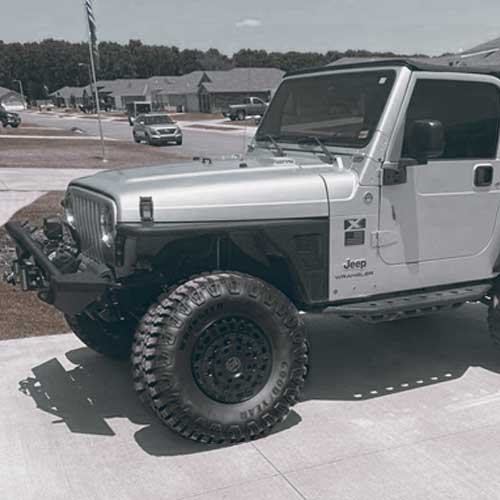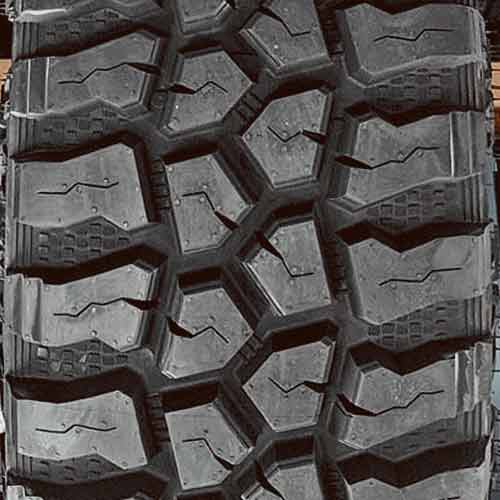The Goodyear Wrangler Boulder MT dominates the mud terrain category with its superior traction and durability in the toughest of terrains. Ideal for off-road enthusiasts, this tire is designed to conquer. But is it really worth the hype? Let’s find out.

Table of Contents
Available Tire Sizes
The Wrangler Boulder MT comes in 15 to 22 inches rims with following specs.
- Speed ratings: P and Q only.
- Load ratings: C, D E, and F.
- Tread depth: 18 to 21/32″.
- Weight: 55 to 80 lbs.
- Treadwear warranty: None.
- Extra Features: TractiveGroove and Duraply Technologies.
- Internal Construction: 3 ply polyester, 2 steel belts and single nylon cap ply.
Tread Design
The Wrangler Boulder MT comes with a very unique yet aggressive tread design.

Let’s start with outer 2 shoulder ribs, where blocks come with zigzag siping and notches facing the middle.
The wide massive groove surrounding these shoulder blocks have another pattern of their own. I mean if you look close enough, you’d note the biters placed at the base of the tread.
Goodyear calls it Tractive Groove Techonology and it basically helps with soft snow and mud traction.
The internal two ribs have symmetrical blocks with similar pattern on them, that is, zigzag siping connected to notches.
And unlike the shoulders they are more packed up together.
Dry Performance
Dry performance in tires boils down to two key aspects: the tire’s handling, which includes evaluating lateral traction and steering response, and its directional grip.
Let me review each of these performance areas in detail.
Longitudinal Grip
The dry grip of a tire is largely influenced by its contact with the road. And here the Goodyear Wrangler Boulder MT, despite having less rubber-to-road contact than some competitors, maintains respectable grip.
And this is through its myriad of biting edges, including sharp sides, notches, and comprehensive siping that connects to these notches.
Its structure features fewer voids than other prominent models like the Toyo M/T, Cooper STT Pro, and BF Goodrich KM3.
So when it comes to directional grip, this tire delivers the shortest braking distance in its class, (saying this after testing out all the other tires in its MT category).
Lateral Grip and Handling
Handling in a tire is a mix of lateral grip and steering responsiveness.
The lateral traction is significantly influenced by the tire’s shoulders, which engage more actively with the road surface due to centripetal force.
Now in the world of top-tier mud terrain tires, the Goodyear Wrangler Boulder MT performs admirably, I must say.
But yes, it could benefit from more refined steering feedback.
I mean, while its relatively lighter weight contributes to its high responsiveness, the softer rubber composition tends to flex more.
This flexing causes a delay, affecting the steering dynamics and making it feel more sluggish, thus requiring greater effort to accurately respond to driver inputs.
Wet Performance
Wet traction relies on the tire’s ability to expel water, primarily through sipes and tread voids. The grooves effectively channel water away, while sipes address residual moisture at a microscopic level, enhancing the tire’s contact with the road.
Now here the Goodyear Wrangler Boulder MT exhibits commendable wet traction capabilities.
To give you an idea, on a wet skidpad test, it achieves an average lateral g-force of 0.76 g, ranking it highly among mud-terrain tires.
And this performance is attributed to the tire’s substantial number of sipes, which are uniquely angled to maximize water extraction and improve road grip.
Winter Performance
Although the Goodyear Wrangler Boulder MT lacks the 3-peak mountain snowflake rating typical of dedicated winter tires, its performance in snowy conditions is notably effective.
The tire features robust shoulder scoops and sidewall lugs that adeptly navigate through thick snow. Its design includes multiple biting edges, formed by sipes and notches, which trap snow particles within the tread.
This interaction promotes increased friction, as snow tends to cohere, enhancing the tire’s grip by forming a compact layer more adhesive than rubber alone.
Ride Quality
The measure of a tire’s ride quality lies in how well it can reduce vibrations from the road and lower noise levels, thereby increasing the comfort and smoothness of the ride.
Let’s explore how each tire stacks up in these important areas.
Noise Reduction
Tire noise primarily arises when air particles, entering through shoulder voids, clash with tread barriers. This is a common issue with all mud tires, known for their robustness and louder sound profiles.
The Goodyear Wrangler Boulder MT stands out for being louder than many other mud tires, a characteristic attributed to its unique tread design that promotes in-groove resonance.
This phenomenon results from sound echoing within the tread spaces, exacerbated by certain rubber compounds, including those used in this tire.
During tests, the Goodyear Wrangler Boulder MT was noticeably audible beyond speeds of 30 mph, discernible even with windows up and the radio on. While its variable pitch technology attempts to mitigate noise by varying the tread pattern to produce different sound frequencies that can cancel each other out, a notable increase in noise levels after 10,000 miles is still to be expected.
On-Road Vibrations
The Goodyear Wrangler Boulder MT demonstrates adequate responsiveness in on-road handling; however, its firmer tread compound limits its ability to dampen vibrations effectively.
The tire’s rubber composition is less elastic, which means it does not cushion road irregularities as well as some other popular mud-terrain options.
Despite having a considerable tread depth of up to 21/32 inches, it remains below average compared to other mud tires.
A deeper tread depth typically allows for a thicker buffer of rubber between the tire and the road, providing a greater area to absorb and dissipate vibrations before they reach the driver, enhancing ride comfort.
Fuel Economy
Let’s delve into the realm of fuel efficiency with the Goodyear Wrangler Boulder MT—a tire that truly stands out in its category. Although it’s a common belief that mud-terrain tires are heavy on fuel consumption, the Goodyear Wrangler Boulder MT challenges this notion impressively.
Among its peers in the mud-terrain segment, this tire proudly ranks within the top three for fuel economy, based on my comprehensive testing. I’ve scrutinized a broad range of tires, so feel free to drop a comment if there’s one I might have missed.
The secret to its efficiency lies in its lower rolling resistance. Thanks to a dual tread compound, the tire supports its blocks robustly, reducing their tendency to bend or flex when the tire undergoes weight shifts or navigational pressures—like cornering or braking.
This rigidity in the tread blocks prevents unnecessary energy expenditure, keeping the rolling resistance on the lower side compared to its competitors.
Off-Road Performance
The complexity of off-road terrains varies greatly, encompassing everything from muddy environments to roads filled with gravel and dirt. Interestingly, some of these terrains are actually better suited to tires designed for on-road use. Let’s take a closer look at these diverse terrains.
On Rocks
When it comes to rocky terrains, the necessity for durability and puncture resistance becomes paramount. Here, the Goodyear Wrangler Boulder MT shines with its exceptional toughness and resistance to cuts, thanks to its durable rubber blend fortified with Kevlar.
While most mud-terrain tires offer comparable performance on rocky grounds, the Goodyear Wrangler Boulder MT stands out.
Its tread flexibility is slightly more elastic, allowing the tire lugs to conform more easily to rocky surfaces, ensuring superior grip. Additionally, when the tire pressure is reduced, the sidewall lugs become particularly effective.
They grasp and pull at the terrain, providing a notable advantage over other mud tires which also feature thick lugs, but may not offer the same level of engagement with the rocky path.
On Sand
Navigating sandy terrains calls for tires that excel in flotation and shoveling capabilities—a domain where mud tires typically shine.
And among these, the Goodyear Wrangler Boulder MT stands out, comfortably ranking within the top five.
But what sets this boy apart? Well consider the following.
First off the Goodyear Wrangler Boulder MT is adept at maintaining a substantial contact area with the sand, which is crucial for stability and traction. This is enhanced by the tire’s ability to soften its tread further when the air pressure is lowered, allowing it to adhere better to the soft sandy surfaces.
Additionally, its outer edges are softer and less prone to digging into the sand—an action that can severely hamper traction.
Moreover, the tire’s elongated shoulder lugs act like paddles. They efficiently throw sand backward, helping to generate forward momentum, especially helpful on sandy inclines.
On Mud
Mud terrain (MT) tires, as suggested by their name, are built for mastery over muddy environments, and the Goodyear Wrangler Boulder MT is a prime example of peak performance in these conditions.
Now it leads the pack with several notable features, and out of them the most important ones are following.
Firstly, the tire’s design incorporates expansive lateral and longitudinal tread voids, which play a critical role in mud evacuation. These voids allow thick mud and wet debris to be expelled quickly, preventing build-up and maintaining traction.
The layout of the tire’s thick, slanted lugs and staggered shoulder blocks is engineered to effectively scoop and displace mud backward, propelling the vehicle forward even through heavy, sticky mud.
Furthermore, the Goodyear Wrangler Boulder MT’s robust sidewall lugs enhance its ability to claw through mud, contributing significantly to its capabilities in ‘getting-out’ situations where lesser tires might falter.
In Conclusion
So in summary, the Goodyear Wrangler Boulder MT distinguishes itself across various performance metrics, making it a decent choice in the world of mud-terrain tires.
From dry roads where it demonstrates respectable grip despite limited rubber-to-road contact, to the challenging muddiness where it excels in mud evacuation and traction, this tire proves versatile and reliable.
Plus its performance on sand and rocks showcases its adaptability, with features that enhance flotation and prevent digging in, while its robust design and enhanced shoulder lugs enable effective navigation through rugged terrains.
And yes, despite its somewhat louder noise profile and less effective vibration damping on-road, the tire’s overall competence in handling diverse and challenging conditions solidifies its top-ranking status among specialized off-road tires.